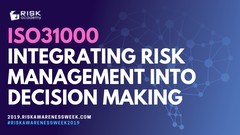Наши популярные онлайн курсы
Speaking at Risk Awareness Week, Max Henrion founder and CEO of Lumina Decision Systems, described the power of uncertainty modelling and when risk managers should apply a stochastic lens for decision-making.
When you’ve got to catch an early morning flight – how much time do you leave to get to the airport? This was the question asked by Max Henrion, founder and CEO of Lumina Decision Systems to the audience at Risk Awareness Week.
It’s a decision many of us grapple with several times a year, and one which probably depends on your risk appetite, not to mention how much you like a lie in.
Henrion explained that when faced this issue, almost all of us apply some sort of basic best estimating, knowing that there are several uncertain factors at play.
Inherently, we all know that we need to leave extra time for our journey, as the alternative is missing the flight. So, we consider factors such as what traffic is usually like, how long it will take us to clear security, how far the walk to the gate is and so on.
At the same time, no matter how keen we are to make it to the plane on time, we usually try to avoid getting to the flight 12 hours early, as we want to minimise the time we waste sitting at the gate.
Such decision making – which is based around the uncertainties involved in a trip to the airport – come naturally to most of us. But despite this, a huge amount of business planning and decision making is deterministic, Henrion explained.
To demonstrate the risks of such an approach, Henrion modelled the airport travel time problem, using both a deterministic and a probabilistic approach in the Analytica system.
Using a median deterministic model, the analysis said that he needed to leave 80 minutes before his flight. When probabilities were included, the model shows that the actual ideal time to leave for the airport was 110 minutes before the flight.
The results are not surprising – we all know that if we calculate our average journey time and use that to decide when to leave, we’ll be late almost half of the time – and in this case, we’ll end up having to waste even more time while we try to arrange a replacement flight.
Clearly, in this case doing a probabilistic model leads to less wastage and less risk overall. And there’s more that can be done with uncertainty modelling. For instance, the Analytica software allows risk managers to use tornado diagrams to see how important each individual factor is. This means that probabilities and decisions can be weighted to have the greatest impact on the risk.
So, the question becomes: why is it that risk managers (and other key decision makers) so often ignore uncertainty when they’re modelling decisions?
One answer, according to Henrion, is the perceived cost and effort of doing uncertainty modelling, not to mention the difficulty explaining your results to experts and senior managers who are not used to probability calculations.
However, Henrion argues that uncertainty modelling can actually lead to simpler models as risk managers understand which data points are most important to focus on.
He concluded: “My experience is – if you start out with a simple model; assess the uncertainty of the parameters that you think are going to be most relevant; do the sensitivity analysis; find out what matters and then use that to guide your model refinement – you’re going to end up with a model that focuses on the qualities that make the most difference to your decision.
“It is all worthwhile… First of all, modelling the uncertainty gives you a much deeper understanding of the problem than assuming everything is going to be according to your initial best estimate. Secondly, when you start asking about the range of possible futures, you get a much more interesting and more useful conversation and ultimately it does lead to better decisions.”
When should risk managers consider probabilistic modelling
- When your value (or loss) function is asymmetric in an uncertain quantity
- If you are risk averse (asymmetric function of value)
- If you are combining uncertain information from several sources
- When you must decide whether it’s worth paying for more information to reduce uncertainty
- If you use uncertainty for sensitivity analysis to guide model refinement
- If a deeper examination of uncertainty may change your ‘best estimate’
- When you feel an ethical responsibility to clarify the limits of your uncertainty
Check out other decision making books
RISK-ACADEMY offers online courses

+ Buy now
Informed Risk Taking
Learn 15 practical steps on integrating risk management into decision making, business processes, organizational culture and other activities!
19,999,99

+ Buy now
ISO31000 Integrating Risk Management
Alex Sidorenko, known for his risk management blog http://www.riskacademy.blog, has created a 25-step program to integrate risk management into decision making, core business processes and the overall culture of the organization.
199,999,99

+ Buy now
Управление рисками
В этом коротком и очень увлекательном курсе, Алексей Сидоренко расскажет о причинах внедрения риск менеджмента, об особенностях принятия управленческих решений в ситуации неопределенности и изменениях в новом стандарте ИСО 31000:2018.
19,999,99
































